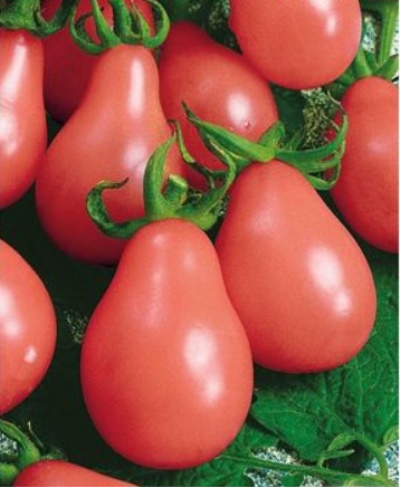
- Authors: V. L. Korochkin, S. A. Korotkov, A. V. Dynnik, A. V. Kochkin (ZAO Scientific and Production Corporation 'NK LTD')
- Year of approval: 2001
- Category: grade
- Growth type: indeterminate
- Appointment: fresh consumption, for whole fruit preservation
- Ripening period: mid-season
- Ripening time, days: 110-115
- Growing conditions: for open ground, for film greenhouses
- Marketability: Yes
- Transportability: Yes
The Pink Pear variety belongs to the category of indeterminate high-yielding tomatoes. The unusual shape of the fruit attracts the attention of summer residents, and the tomatoes themselves are perfectly stored almost until winter, they ripen successfully after picking. Tomato does not lose its properties even after conservation, is perfect for pickling, pickling, and has excellent commercial qualities.
Breeding history
Pink pear was introduced as a variety in 2001. The tomato was bred by ZAO NPK NK LTD. The variety obtained by breeders is registered in the State Register of the Russian Federation.
Description of the variety
The tomato is tall, with strong foliage. Shoots reach a height of 200 cm. Bushes are not ampelous, erect, strong enough, usually with 8 fruit clusters. Shoots are covered with medium-sized green leaves. The inflorescences are simple, the first of them is laid over the 9th leaf, then alternating after 3.
The main qualities of the fruit
Tomatoes are resistant to cracking. This variety of pink tomatoes is famous for its original color, rich, with a pearlescent tint. Unripe fruits are light green, with a darker spot at the stalk, the skin is rather thick. Tomatoes are medium in size, weighing up to 100 g. Their shape resembles a pear, with expansion from the middle of the fruit, there is a slight ribbing on the surface.
Taste characteristics
The tomato has a pulp with a harmonious, sweet and sour taste. The aroma is characteristic, pronounced.
Ripening and fruiting
The variety is mid-season. Ripening lasts 110-115 days.
Yield
According to this indicator, the variety is quite suitable for most summer residents. The collection volumes here reach 6.1-6.7 kg / sq. m.
The timing of planting seedlings and planting in the ground
Tomato Pink pear requires the start of sowing at a relatively early date. The seeds are prepared for planting from the end of February, in colder regions from the beginning of March. They are soaked first in a disinfecting solution, then in a growth stimulator. The seedlings, already stretched up to 30 cm, are transferred to the ground. This happens from the end of April to the 1st decade of May.

Growing tomato seedlings is an extremely important process, because it largely depends on whether the gardener will be able to harvest at all. All aspects must be taken into account, from seedbed preparation to planting in the ground.
Landing scheme
Plants are placed at a distance of 40 × 60 cm.

Growing and care
Tomatoes are tall, therefore, both in greenhouses and in the open field, they are led into 1 stem, be sure to tie them to trellises or stakes. Heavy fruit clusters also need support. All stepchildren and lower leaves must be completely cut off. At the end of the growing season, the growing point should be pinched.
The variety is also suitable for seedless cultivation.In this case, it is sown directly into the ground, preparing a bed with a large amount of organic matter. Young seedlings are covered with agrofibre or other protective materials. It is good if legumes, carrots or radishes were previously grown on the soil allocated for tomatoes.
In greenhouses, it is very important to avoid overheating during the flowering period. When the atmospheric temperature rises to +35 degrees, the pollen becomes sterile. It is also important not to allow waterlogging of the soil. Watering is carried out as needed, with warm settled water.




A plant needs different micronutrients at each stage of growth. All fertilizers can be divided into two groups: mineral and organic. Folk remedies are often used: iodine, yeast, bird droppings, eggshells.
It is important to observe the rate and period of feeding. This also applies to folk remedies and organic fertilizers.
Disease and pest resistance
In the heat, tomato bushes can be affected by late blight. Fungal disease spreads quickly and can spoil crops. As a preventive measure, it is recommended to use the spraying of bushes with copper-containing preparations. Bordeaux liquid or its analogues will do. From white rot, tomatoes need preventive treatment with magnesium and potassium preparations.


Resistant to adverse weather conditions
Pink pear is a tomato that tolerates difficult weather conditions well. It easily adapts to return frost. When planting outdoors, light cover can be used. With a lack of sunlight, fruit ripening slows down.
Growing regions
The Pear rose variety is adapted for cultivation in most regions of the Russian Federation. It can be planted in the Far East and Siberia, the Urals and the Northwest. In the Central Black Earth regions, Krasnodar Territory, Stavropol Territory, cultivation takes place mainly in the open field.
Review overview
Spectacular pear-shaped tomatoes are the dream of many gardeners. It is not surprising that this variety managed to acquire many admirers throughout Russia. Pink pear conquers amateur vegetable growers with its taste, the pulp does not sour when sliced into salads or preserved. The seeds show excellent germination, practically do not give empty shells.The seedlings are not very demanding in care, they only need periodic watering and a lot of sunlight or artificial light.
Some of the disadvantages of the cultivar are called shape changes depending on the cultivation conditions. In addition, the side shoots have to be constantly pinned, preserving the juices for the main trunk. Summer residents do not recommend planting tomatoes of this variety in peat pots, it is better to sow first in a common container, and then pick.

























































































